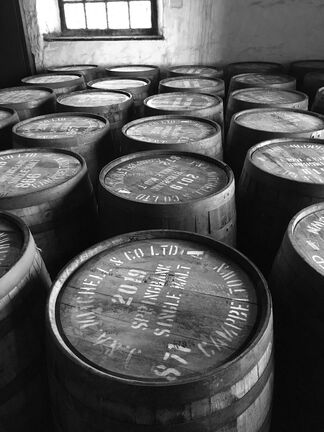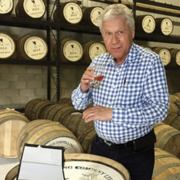
The Power of the Cask
The role of the cask in making whisky
The Scotch Whisky Association regulations state that Scottish whisky must be matured in an oak cask for at least 3 years. Why 3 years? Why oak? Is it a cask, or a barrel? Read on …..
Barrel aging of alcohol started around 350 BC and can be traced back to Celts who had migrated to live in the Alps, where barrels were being used to store ale and wines (and a whole bunch of other things too). Wooden barrels gradually replaced clay vessels which were relatively easily broken.
Over time, wine and ale makers noticed the positive maturing effect that the oak barrel was having over both flavour and colour, and barrel maturation became an essential part of the process of making alcoholic beverages.
And modern distillers are having a wonderful time experimenting with re-used casks. I tried a whisky matured in an ex Tequila cask …. I was not impressed but I am sure someone out there is!
Is it a Barrel or a Cask?
Let's get something clear before going further. Is it a barrel, or is it a cask. With all alcoholic drinks, they mature in a barrel. Except whisky, where it is called a cask. It is the same thing but just has a different name. Nobody seems to know why!
The origin of the word cask is hazy. It possibly comes from the Middle French word "casque" or the Spanish word "casco". Both mean "helmet," but how we got from helmet to whisky-filled barrel-shaped container is a mystery!
The term "barrel" does, however, exist in whisky world but relates to a particular size of a cask. It is 208 Litres in size, and it is the only time in whisky talk that you reference a barrel. More about this later.
Cask Influence on Whisky
After the Distillation phase of making whisky, the spirit is clear like water, and has a rather metallic taste that it gets from the copper stills. Rather nasty, actually. The next phase is the maturation of the whisky in oak casks. This, according to SWA regulations must be a minimum of 3 years. Why 3 years? Well, during maturation in the cask, the spirit interacts with the wood to shape its flavour and colour. It takes 3 years for the wood to remove much of the metallic, unpleasant smell and taste of the spirit. In the same 3 years, the wood has had a chance to pass on both colour and flavour to the spirit, which can now be called whisky.
Several factors influence the cask maturation process. These include the type of the wood the cask is made from, what was in the cask before the spirit, the size of the cask, the duration of storage, and the environment in which the casks are stored. Whiskies from one and the same distillery can have different flavour and colour profiles, as even the smallest changes in the maturation process have a major impact. Lets have a look at each of these.
Which Wood is used for the Cask?
Oak is the wood of choice. It is dense and extremely strong and durable. Two main types of oak are used for casks; American oak, and European oak.
American white oak
Used for the production of barrels for bourbon and Tenneessee whiskey. The wood has a high density and contains a lot of monogalloyl glucose, which is responsible for the typical vanilla notes in bourbon.
European oak
Grows more slowly and has a lower density than its American relative. The gallic acid it contains is a vegetable tannin. It causes the bitter notes in the whisky. European oak gives off significantly stronger and spicier flavours than American white oak.
What was in the Barrel before the Whisky
Casks used for whisky can be virgin oak, or re-used casks from another beverage such as bourbon, wine, sherry, port, madeira etc. Or it may have contained another batch of whisky. And modern distillers are having a wonderful time experimenting with re-used casks. I tried a whisky matured in an ex Tequila cask …. I was not impressed but I am sure someone out there is!
But now the story gets more complicated. A distiller may decide that after several years in a particular cask, the whisky may improve if it is "finished" in a different type of cask. So the whole cask contents is transferred to another "finishing cask" and left for another period of time.
And just to mess with your head even more, a distiller can decide that two (or more) casks of whisky with completely different colours and flavours may benefit from being mixed together. The whisky is still single malt if coming from a single distillery, and can still carry an age statement. This whisky is called a "double wood" (if 2 casks are mixed), or a "triple wood" (if 3 casks are mixed).
The Size of the Cask
Whisky matures faster in smaller casks. The reason is that the surface area of contact between spirit and wood, proportional to the volume of spirit in the cask, is larger. This intensifies the influence of the cask. Size matters!
Here is a list of the capacities of the main cask types:
| Cask Name | Capacity in litres |
|---|---|
| Octave | 50 |
| Quarter Cask | 50/125 (Quarter of a barrel or a Butt) |
| Barrel | 208 |
| Barrique | 225 |
| Hogshead | 250 |
| Butt | 500 |
| Port Pipe | 500-600 |
Did you notice the name "barrel" in there? The use of the name Barrel for a 208 Litre Cask comes from the USA. Bourbon is matured in oak barrels (208 Litres in capacity). And they are only used once before being discarded. This was a life saver for the Scottish distilleries in the 1800's and early 1900's.
Oak was used to build ships before steel was used. As the British Navy grew, the supply of oak for making barrels was limited. Scottish distillers needed a solution and found it in America. The Scottish distillers bought up the discarded, single-use, bourbon casks! And used them for maturing whisky.
Duration of Maturation and Environment
The age of a whisky is the length of time it spends in the cask. Unlike wine, which is dated as the year it is made, and ages in the bottle. Whisky does not age in the bottle. Only in the cask. The perfect age of a particular whisky is hotly debated, but this is all really a matter of personal taste. But the longer the whisky sits in the cask, the weaker the metallic taste of the stills becomes, and the more influence the wood can have over flavour and taste. And then there the "Angel's share". Being high in alcohol, whisky evaporates - the alcohol content, as well as the quantity of whisky in the cask will reduce. Thus making older whiskies more expensive because there is less of it! Personally, I keep an open mind. I have had some wonderful whiskies that are only 3 years old. And some amazing whiskies that are much older. My advice is to just try them and see what you like.
But as the alcohol evaporates, and the volume of liquid in the cask reduces, that space created is filled up by the air from the environment in which the cask is stored. Giving yet another influence to the whisky flavour. Ever noticed the salty, briny taste in a Talisker for example? That is because Talisker warehouses are right next to the ocean and the sea air is infusing into the whisky.
The Life Expectancy of a Cask
Oak casks are very durable and can hold whisky for many decades. However, the flavour that the whisky can absorb from the wood decreases over the years. The cask becomes leached out. Whisky stored in fresh casks therefore absorbs the most flavours.
Casks are expensive. It is therefore common practice in the whisky industry use casks more than once. After 10 years of malt whisky maturation, a cask still contains a lot of flavours and is therefore reused for the next malt. In the industry, they are called refill casks. Refill casks are reused for up to around 30 years.
In the end, there is no doubt that the cask is an incredibly important element in the whisky that we enjoy!

